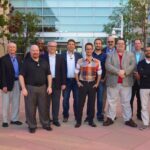|
|
This date is November 6, 2014 at 10:30-12:30.
Delegate Panel: N/A
The videos from this session will be posted soon. Stay tuned!
Learn More
Introducing Nexenta & the Benefit of Software-Defined
Watch on YouTube
Watch on Vimeo
In this industry perspective we will introduce Nexenta, our Software-Defined Storage solution portfolio, business model, and market position; we will also discuss the definitions of “true” Software-Defined Storage, how differentiated technical capabilities map to tangible business benefits, the observed results that demonstrate this, and additional statistics on the state of the industry around SDS.
Personnel: Jill Orhun
NexentaStor – Software Defined Unified Storage Using Industry Standard Hardware
Watch on YouTube
Watch on Vimeo
In this session, we will discuss the high level architecture of NexentaStor, a Software-Defined solution for unified file and block storage. We’ll provide a high level overview of how Nexenta helps solve customers’ pain points by delivering flexible, scalable, and cost-efficient software-defined storage solutions, and share some of our upcoming play for all-SSD configurations.
Personnel: Oscar Wahlberg
Software Defined Storage for VSAN and VDI
Watch on YouTube
Watch on Vimeo
In this session we will talk about the NexentaConnect product family focusing on the upcoming release of Nexentaconnect for VMware Virtual SAN and Nextena’s vision of simplifying storage for everyone. Session includes a deep dive into architecture of NexentaConnect for VMware Virtual SAN, automations, and ZFS fine-tuning.
Personnel: Murat Karslioglu
Why Eventually Consistent Object Storage Should Not Use Consistent Hashing
Watch on YouTube
Watch on Vimeo
In this session we will introduce Nexenta’s next generation object storage solution, NexentaEdge, and provide an architectural overview of the integration with OpenStack before diving deeper into the technical details in a “chalk talk”. During the chalk talk we will cover the architecture of the NexentaEdge Object Cluster that supports a unified global namespace across clusters of clusters and performs distributed deduplication, leveraging off a new form of hashing, Flexhash (TM) and Replicast, a reliable form of Multicast UDP.
Personnel: Robert Novak








